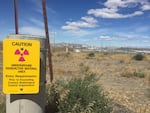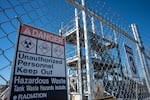
The Hanford Site in southeastern Washington is pictured in this 2020 photo. The nuclear reservation includes 56 million gallons of radioactive waste across 580 square miles.
Anna King / Northwest News Network
Eighty years ago this September, the first industrial nuclear reactor went online near Richland, Washington, on what would become known as the Hanford Nuclear Reservation. The plutonium refined at the site as part of World War II’s Manhattan Project fueled the atomic bomb dropped on Nagasaki, Japan, and much of the stockpile of nuclear weapons created during the Cold War.
For decades, more than 400 billion gallons of contaminated waste seeped into the earth around Hanford — a fact that was only made public years later due to a culture of secrecy born in wartime.

Caution signs warn of radioactive materials at the Tank-Side Cesium Removal (TSCR) System process enclosure outside AP Tank Farm on the Hanford Nuclear Reservation, in this photo on September 24, 2024. The Tank Farm will be used as a staging place for the all the tank waste that will be fed into the Waste Treatment and Immobilization Plant for vitrification; it will be the last farm cleaned up at the end of the tank farm cleanup mission.
Courtesy Annie Warren/NWPB
Currently, 177 massive underground tanks collectively hold 56 million gallons of radioactive waste at the Hanford site. Plans for how to contain and safely store that waste have been evolving and changing for years.
“Think Out Loud” toured the Hanford nuclear reservation in September and conducted a series of conversations with Department of Energy officials and others involved in dealing with the toxic waste left from decades of nuclear weapons production.
Karthik Subramanian, the chief operating officer of the DOE contractor in charge of managing the tank farms, says the newer tanks are much safer than the ones originally built on the site.

"Think Out Loud" host Dave Miller interviewing DOE contractor Karthik Subramanian about storing nuclear waste on Hanford’s tank farms, Tues. Sept. 24, 2024.
Courtesy Annie Warren/NWPB / OPB
“These tanks are about a million gallons in volume, and they’re about 85 feet in diameter, about 30 feet tall. And then they are buried with the top of the tank at about a 12 feet level,” Subramanian told us. “So they’re buried quite a bit underground. And then each of those tanks is completely secondarily contained in another tank.”
About one-third of the tanks are known to have leaked, according to the DOE, and 28 have been double-walled. The plan is to do that for all 177 of the tanks, which were originally designed to last just 20 years.
A pipe goes from that tank farm Subramanian described to an enormous waste treatment plant, also known as the vitrification plant, which will process the radioactive material.

In 2023, the U.S. Department of Energy announced the first set of clean test glass was successfully poured into a stainless-steel storage container designed to hold vitrified waste at Hanford’s Waste Treatment and Immobilization Plant, also known as the Vitrification Plant. In this photo, taken Tues. Sept. 24, 2024, the container showcases the signatures of workers, managers, suppliers and stakeholders celebrating the achievement.
Courtesy Annie Warren/NWPB
Huge melters will be used to turn liquid waste into solid — but still radioactive — glass. Steel canisters, weighing more than 15,000 pounds when filled, will hold that glass.
Safety, said Subramanian, is his chief charge, especially for the people who work on-site.
“As in any nuclear industry, there’s a lot of layers of procedural compliance to ensure that there is multiple layers of defense against any errors that would have impact,” he said. “We have procedures that are meant to support the folks doing the work.”
Brian Vance, who is in charge of all work at the Hanford Nuclear Reservation for the DOE, says the culture of safety at the site goes hand in hand with a new one of transparency, which he says is replacing the former culture of secrecy.
“I think openness and transparency are two of the things that I’m most proud of, that we’ve spent considerable amount of time investing in, not only with our community, but with regional stakeholders, the Tribal Nations, the national community as well,” said Vance. “But we also want to own when we have less than successful outcomes. Like this summer, we announced a small leak from Tank T-101 and the T-Farm … My determination was from a conservative perspective, we’re going to call it a leaking tank and we’re going to communicate right away.”
The nonprofit group Hanford Challenge has been focused full-time on monitoring the government processes and communication about the cleanup since it was formed 17 years ago by long-time accountability advocate Tom Carpenter.
The group was among those that submitted public comments on the latest cleanup agreement announced by the state of Washington and federal agencies including the U.S. Department of Energy. That comment period closed in September.

Miya Burke, program manager for Hanford Challenge, appears in this undated photo provided by the organization.
Courtesy Hanford Challenge
Miya Burke, program manager for Hanford Challenge, agrees there is more openness at the DOE now, but her group has been contending with the culture of secrecy since its inception.
“In terms of secrecy, the Department of Energy was born out of the Manhattan Project, out of the Atomic Energy Commission,” Burke said. “And when you’re born out of the culture of secrecy and your identity is tied to secrecy, I think it’s really hard to let that go and move away from that culture of hiding.
Burke says she has “mixed feelings” about the new agreement.
“It’s a step forward. They were in these holistic negotiations, which were secret – they did not share any information with stakeholders, the public or the Tribes for four years,” she said. “We were happy to finally hear what the settlement agreement was, but it still feels like kicking the can down the road .... And it feels like it’s a delay on top of many, many delays.”
One of the biggest safety concerns Hanford Challenge has involved an alternative to vitrification known as grouting — essentially immobilizing waste in concrete, rather than glass.
“[T]hey’re considering shipping tens of millions of gallons of tank waste off-site and grouting it,” she said. “So we’re really concerned around that proposal. We don’t know a lot of specifics. We don’t know if the waste is going to be shipped as a liquid or as a solid grouted form.
As DOE’s top Hanford manager, Vance said previous testing of grout indicates that it is safe. But he said before any decisions are made about the larger volumes of waste, they’re conducting another pilot called the Test Bed Initiative on a smaller amount.
“We’re going to treat the tank waste,” he said, “to remove the majority of the radiological content. The 2,000 gallons will be placed in Department of Transportation-approved containers, with really very benign chemical constituent and almost no radiological content. And the plan is to transport it via truck to locations in Texas and Utah, to demonstrate the capability to do that safely.”
Burke says Hanford Challenge and other environmental watchdogs have grave concerns about containing this kind of waste in concrete rather than glass.
“There was a grout program at Hanford in the 80s and it was shuttered in 1993. It was due to issues with successfully grouting the Hanford’s tank waste. So this is something that’s really, really difficult. A lot of the studies will look at other sites — Savannah River and other sites — that have successfully grouted tank waste. And yet Hanford’s waste is like no other. It has a really varied complex chemistry.”
And Burke says that complexity necessitates a different approach.
The public comment period on the agreement that federal and state agencies came to this year, known as the Holistic Agreement, closed in September. Vance says managers will use that feedback to inform the decision about whether to grout at Hanford or transport liquid waste to Texas and Utah for grouting.
But whatever form it’s moved in, 2,000 gallons of treated radioactive waste is scheduled to be trucked through routes in the Pacific Northwest as part of the Test Bed Initiative — and that is scheduled to begin in 2025.
To listen to the full interview with Miya Burke of Hanford Challenge, click the play button below.
To hear the audio of our visit to the Tank Farm at Hanford, and the interviews with DOE contractor Karthik Subramanian and Brian Vance, the DOE’s top manager at Hanford, click the play button below.
